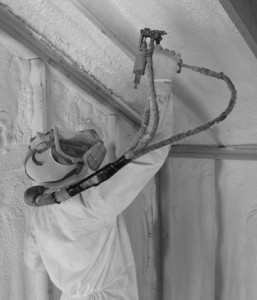 The Environmental Protection Agency hosted over 300 spray foam industry professionals and concerned viewers in an online seminar to introduce the agencies’ collective concerns and involvement with the safety practices and health risks associated with the handling, application, and life cycle usage of spray polyurethane foam.
The Environmental Protection Agency hosted over 300 spray foam industry professionals and concerned viewers in an online seminar to introduce the agencies’ collective concerns and involvement with the safety practices and health risks associated with the handling, application, and life cycle usage of spray polyurethane foam.
Involvement included:
- EPA
- OSHA
- NIOSH
- CPSC
- The Center for Polyurethanes Industry, and
- Spray Polyurethane Foam Alliance (SPFA) trade associations
The SPFA reports market growth of up to 40% since 2004. The EPA sited a report indicating that over 400 million pounds of polyurethane foam were consumed in North America during 2008.
The presentation several goals of the EPA initiative:
- Improve Availability of Safety Information
- Communicate Best Safety Practices
- Address Inaccurate and False Marketing Claims
- Exposure Assessment
According to information made by the EPA, another webinar will be held regarding Spray Foam due to demand. Stay tuned to OHShub.com for more information.
Source: Sprayfoam.com
Mary Cushmac, from the EPA opened up the meeting with comments about the current situation in the industry as it relates to the government agency’s perspective. She indicated that both the A-side product and B-side products contain both primary and intermediate chemicals of concern, especially if they are mis-handled, or applied incorrectly.
EPA mentioned that the “applicators themselves” of the foam insulation are often in a work-hazard situation that exceeds the current OSHA / NIOSH exposure limits to isocyanate. Therefore it is imperative that the applicators, helpers, and nearby trades be properly educated and protected. Proper Personal Protective Equipment (PPE) is used, including but not limited to, full skin coverage, and full face respirators. Helpers should also be wearing full face respirators.
It was also emphasized that the building having foam applied, be vacated by the occupants (homeowners, school children, other workers), during the application of spray foam. This procedure is just as for the foam insulation contractor to know and abide by as it is to the consumer/homeowner having the work done.
The big concern and open ended question now revolves around just exactly how long should the building or space remain unoccupied after application. The general, very conservative, “best practices” rule of thumb has been discussed to be 24 hours. However, current research indicates that some tests have shown that no levels of isocyanate were detectable after just a few hours. It was agreed that more research is necessary and that many other variables also come into play in this decision.
Post application procedures should also be scrutinized as there is some concern that the dust created by the shaved foam may contain uncured chemicals that can lead to iso inhalation and skin irritation exposure.
Several other presentations were made by Janet Carter (OSHA), Daniel Almaguer (NIOSH), Treye Thomas (CPSC), Jim Chapman (Bayer MaterialScience), and the industry trade associations. Presentations covered more on the need for better safety practices, and the areas in most need. A major goal of this government and trade based coalition will be to communicate and educate all of current and future users of the product (trade and consumer side) all of these highlighted safety and health advisory precautions.
